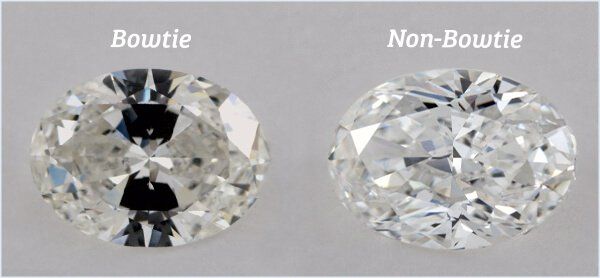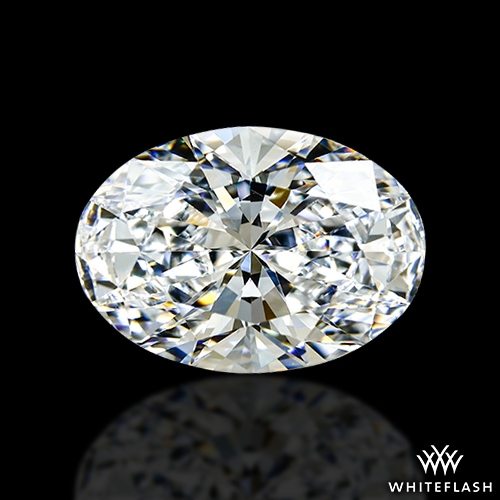Alive with fire and brilliance, the oval cut is often considered to be one of the most flattering diamond cuts for an engagement ring. The soft curves and elongated shape give an elegant look to the hand and a high-quality oval cut can offer all the sparkle of a round brilliant while giving a flourish of uniqueness to the ring. It is also a cut that optimizes carat weight, meaning the longer shape of the diamond causes it to appear larger than other cuts of the same carat weight.
Summary:
- Oval Cut
- Oval Length to Width Ratio
- The Bow-Tie Effect
- Oval Color
- Oval Clarity
- Oval-Cut Lab Diamonds
- Recommended Settings for Oval Diamonds
- The Final Word
Variations of oval shaped diamonds adorned hands for hundred of years, however, it was in 1957 that renowned diamond cutter Lazare Kaplan created the oval cut that we recognise today. Kaplan was born into a family of jewelers and worked closely with his uncle Abraham Tolkowsky (the inventor of the ideal cut) to create the ultimate oval cut diamond.
The oval cut may not hold the same level of popularity as the round brilliant but it continues to be the perfect choice for those who seek the brilliance of a round but desire something just a little different to stand out from the crowd.
Cut
Certification is absolutely essential when buying any diamond. The GIA are the most reliable body (for natural diamonds) and the IGI (for lab diamonds) who can offer an accurate and internationally respected grades for your diamonds making them your best friend when buying a diamond. However, the GIA do not offer a cut grading for an oval cut diamond. Furthermore, due to the complex nature of this unique cut, it is almost impossible to determine any set parameters regarding cut and proportions. Put simply, there are no ‘magic numbers’ when it comes to an oval cut.
Do not let this put you off. Choosing a diamond is all about what you see and there are other ways to determine the quality of an oval cut without an assigned set of figures.
That said, I have created a rough guideline for the cutting proportions of an oval cut. These can be used in conjunction with other aesthetic aspects (such as the bow-tie effect which we will look at later) to help you build an idea of the best oval cut for you.
| EXCELLENT | VERY GOOD | GOOD | FAIR | POOR | |
| Table % | 53 - 63 | 52 or 64 - 65 | 51 or 66 - 68 | 50 or 69 - 70 | < 50 or > 70 |
| Depth % | 58 - 62 | 56 - 57.9 or 62.1 - 66 | 53 - 55.9 or 66.1 - 71 | 50 - 52.9 or 71.1 - 74 | < 50 or > 70 |
| Girdle | Very Thin - Slightly Thick | Very Thin to Thick | Very Thin to Very Thick | Ex. Thin to Ex. Thick | |
| Culet | None | Very Small | Small | Medium | > Medium |
You can use this chart as a starting point for evaluating the quality of an oval cut diamond, however remember that there is an exciting element of freedom surrounding this cut. It is much more about what looks the best to you than it is about percentages.
Length to Width Ratio
A length to width ratio will indicate how proportionate a diamond is with the shape it is meant to be. This ratio also helps us to understand how the diamond will really look, for example whether the diamond will be elongated and slim or squat and rounded.
Ratios of 1.30 to 1.50 are the most commonly chosen for an oval cut diamond, however as you can see in this image there is a huge spectrum of ratios, and it is entirely up to you which you select. Be aware that opting for a very slim ratio (anything above 1.75) or anything too rounded (1.20 and below) may mean you lose the soft, flattering proportions of a true oval cut diamond.
James Allen has a large selection of Oval Cut Diamonds as has Blue Nile. If you’re considering a princess cut or round cut diamond however, head to Whiteflash and look at their A CUT ABOVE diamonds. These are in my opinion the best cut diamonds available.
For lab diamonds Whiteflash leads the lab-grown diamond market with their exceptional quality, precision, and craftsmanship. Their meticulously crafted Precision Cut Lab Diamonds stand unrivaled.
The Bow-Tie Effect
The bow-tie effect describes a dark shadow that casts across the diamond in the shape of a bow tie. A prominent bow-tie shadow will greatly diminish the sparkle and brilliance of an oval cut diamond and emphasises the importance of viewing the diamond in the best possible conditions (i.e. high-res imaging) before buying. This 0.82ct oval cut diamond from James Allen displays by the bow tie effect and shows how an intense shadow can detract from the beauty of the stone. Look for diamonds that do not carry this flaw.

Color
To ensure your oval cut diamond looks colorless in a white setting (such as white gold or platinum) I recommend an H in color. This is the sweet spot between price and quality, and this grade is considered to be ‘near colorless’ by the GIA.

Color is a highly personal part of the diamond aesthetic; some people (though not many) are able to recognise slight hues of yellow in diamonds that appear colorless to others. If this applies to you, look at diamonds with a color grading of G. I would not suggest going higher than this, as the price difference will be sizeable while the difference in appearance will be non-existent.
If you are setting your diamond in a warm setting (such as yellow or rose gold) you may consider diamonds that are an I-J in color. Against the tones of the metal, these gradings can still look colorless.
Clarity
With its 58 facets and unique shape, an oval cut diamond excels at hiding inclusions, making it an ideal choice for those on a budget. You can secure a visually stunning, eye-clean oval diamond even at an SI1 clarity grading. This means you can still enjoy the mesmerizing brilliance and fire of a diamond without having to spend a fortune.

Despite your budget, it's advisable to start your search from the SI1 clarity grade. The paramount consideration should always be the diamond's appearance. An SI1 graded diamond with inclusions cleverly masked along the edges can exude a radiance akin to a higher clarity grade like VVS, saving you significantly in cost.
It's essential to make full use of available visual aids when selecting your diamond. High-resolution photos and videos can provide a comprehensive understanding of the diamond's clarity and the impact of any inclusions. This visual check will ensure that you're choosing a diamond that is truly eye-clean, offering the most sparkle for your budget.
Oval-Cut Lab Diamonds
In the realm of affordable alternatives to natural diamonds, lab-grown diamonds are revolutionizing the industry. These diamonds, identical in their physical and chemical properties to those extracted from the earth, are cultivated in a laboratory setting, making them an eco-friendlier and more cost-effective choice. Brilliant Earth and James Allen are well-established providers in this sector, each offering a diverse range of beautiful oval lab-grown diamonds. Their selections cater to various tastes and budgets, making the dream of owning a sparkling oval diamond accessible to many more people.
However, when it comes to quality, precision, and craftsmanship, Whiteflash sits at the pinnacle of lab-grown diamond providers. Their Precision Cut Lab Diamonds are intricately designed, ensuring every facet plays its part in maximizing the stone's brilliance. The oval cut lab diamonds from Whiteflash have been honed to perfection, radiating fire and scintillation that rivals, and in many cases surpasses, their natural counterparts. Each of these diamonds undergoes rigorous quality control checks and comes with a detailed performance analysis report, reinforcing the high standards that Whiteflash consistently upholds. Their offerings promise a captivating blend of affordability, sustainable sourcing, and top-tier quality, making them an ideal choice for those seeking the allure of an oval diamond without the hefty price tag.
Recommended Settings for Oval Diamonds
Choosing the right setting for your oval diamond can truly enhance its beauty and unique shape. Here are a few settings that I would recommend:
-
Halo Setting: This setting surrounds the oval diamond with a ring of smaller diamonds or gemstones, making the center diamond appear larger and even more brilliant. It's an excellent choice if you're after a glamorous, eye-catching effect.
-
Solitaire Setting: The solitaire setting allows the oval diamond to take center stage. This timeless design often features a simple band that leads the eye directly to the diamond. For an added touch of elegance, you could opt for a slender, tapered band that can make the diamond appear larger and your fingers more slender.
-
Pavé Setting: In a pavé setting, small diamonds line the band, creating a glittering path that leads to the oval center diamond. This adds extra sparkle and can make the overall ring appear larger.
-
Bezel Setting: For a modern, sleek look, the bezel setting encases the oval diamond in a thin frame of metal. It's perfect for those leading an active lifestyle, as this setting offers a high level of protection to the diamond.
-
Three-Stone Setting: This setting features two smaller diamonds or gemstones on either side of the oval diamond, symbolizing the past, present, and future. It's a romantic choice that also adds significant sparkle.
Remember, the best setting for your oval diamond is the one that aligns with your personal style and lifestyle needs. Each setting brings its own unique beauty to the overall look of the diamond ring.
The Final Word
As there is less demand for ovals than there are for other diamond cuts (such as round and princess) you can expect to pay less per carat for these unusual stones. There is also less waste from the rough when an oval is cut, which again makes them less costly than their highly popular counterparts. An oval diamond truly delivers on all fronts; a flattering cut with optimized carat weight, a concealer of color and inclusions and above all a brilliance and fire that can stand up to any round brilliant.
A GIA (or IGI lab) certified diamond is the perfect choice for those looking to break from the norm with an elegant and sparkling selection that sets them apart from the crowd. James Allen and Blue Nile offer good options on both natural and lab diamonds, however for the highest quality cut natural and lab diamonds consider Whiteflash.

